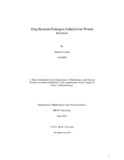Drug resistant pathogens isolated from wound infection

View/Open
Date
2021-06Publisher
Brac UniversityAuthor
Yasmin, FarhanaMetadata
Show full item recordAbstract
For several decades antimicrobial resistance is growing rapidly and limiting the efficacy of antibiotics. Resistance to antibiotics can be accelerated by a variety of factors including human practices, drug tolerance, drug destruction and drug impermeability.
In this study, the prevalence, types and antibiotic susceptibility of microorganisms isolated from pus samples were investigated. A total 200 pus samples of both sex between age group 0-90 years were analyzed in this study. These specimens were analyzed to observe the antibiotic susceptibility having significant growth of pyogenic bacteria. Gram-positive organisms accounted for 35% and Gram-negative organisms accounted for 64% which is almost double of total Gram-positive isolates comparatively. Most of the Gram-positive bacteria were resistant against Cephalosporin group and sensitive towards Carbapenem group’s Imipenem but resistant against Meropenem. Such as Cefixime (92)% and Ceftazidime (94)% were highly resistant in Staphylococcus aureus. In Enterococcus Imipenem was (20)% and Meropenem was (80)%. On the other hand, in Gram-negative bacteria Escherichia coli, Acinetobacter and Pseudomonas spp showed most resistance against the antibiotics.
This investigation intended to decide the prevalence of various bacterial microbes and their antibiotic susceptibility in different sorts of wound contaminations.
